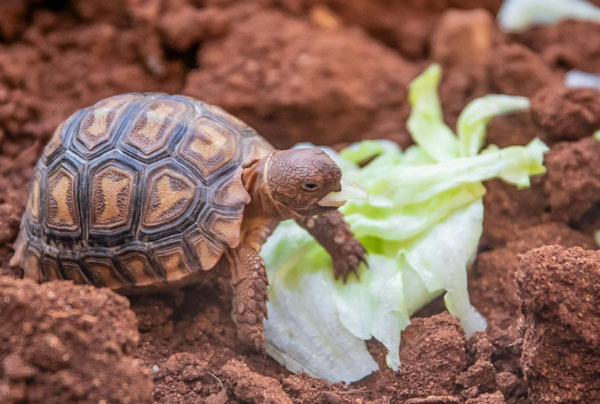What Do Turtles Eat: A Complete Guide to Their Diet
Whether you’re a new turtle owner or just curious, knowing what turtles eat is essential for their care. Turtles, like all animals, require a balanced diet to stay healthy. In this article, we will explore the types of turtles and their diets, outlining what animals, vegetables, and fruits turtles eat, along with how much to feed them.

Types of Turtles and Their Diets
Turtles vary significantly in their dietary needs depending on their species. Understanding these differences is crucial for proper care.
Aquatic Turtles: These turtles, like the Red-Eared Slider, primarily consume fish, aquatic vegetation, and algae. Protein is vital for them during their developmental stages.
Land Turtles (Tortoises): Tortoises such as the Russian Tortoise have a more herbivorous diet. They often eat leafy greens, vegetables, and some fruits.
Semi-Aquatic Turtles: Box turtles fall into this category and have a mixed diet. They consume insects, worms, vegetation, and occasionally fruits.
By understanding the specific dietary needs of your turtle species, you can ensure they receive the necessary nutrients for a long and healthy life.
What Animals Do Turtles Eat?
Turtles, particularly those in the wild, have diverse diets that often include various small animals and insects.
Fish: Aquatic turtles like the Painted Turtle enjoy catching and eating small fish. This provides them with essential proteins and fats.
Insects: Crickets, beetles, and ants are part of many turtles’ diets. These insects offer vital proteins and minerals.
Worms and Snails: These are particularly favored by Land and Semi-Aquatic Turtles. They provide a good source of protein and calcium, which are crucial for shell development.
Aquatic Invertebrates: Turtles might eat crayfish, shrimp, and other small aquatic organisms. These are excellent protein sources and help maintain a balanced diet.
Feeding your turtle a variety of these animal-based foods can mimic their natural diet, contributing to their overall health and vitality.
What Vegetables Do Turtles Eat?
Vegetables are a staple in many turtles’ diets, providing essential vitamins and minerals.

Leafy Greens: Kale, collard greens, and dandelion greens are ideal for most species. They are rich in calcium and low in phosphorus, which is beneficial for shell health.
Squash and Pumpkin: These are good sources of fiber and vitamins A and C. They promote healthy digestion and immune function.
Carrots Tops: Carrot tops are high in vitamins and minerals, especially vitamin A, and are fantastic for maintaining good eyesight and overall health.
Bell Peppers: These crunchy vegetables are liked by many turtles. They offer a range of vitamins and antioxidants.
Green Beans: Packed with vitamins and low in calories, green beans are great for promoting a healthy weight.
Ensuring a variety of vegetables will help keep your turtle’s diet balanced and nutritious.
What Fruits Do Turtles Eat?
While fruits should only make up a small part of a turtle’s diet, they can still provide vital nutrients and be a tasty treat.
Berries: Strawberries, blueberries, and raspberries are popular among turtles. They are high in antioxidants and vitamins.
Apples: Sliced apples are enjoyed by many species. They provide fiber and vitamin C but should be seed-free.
Melon: Watermelon and cantaloupe are hydrating and full of vitamins A and C. They are also easy for turtles to chew.
Papaya: This tropical fruit is rich in vitamins and enzymes that aid digestion. It’s an excellent occasional treat.
Feeding fruits sparingly is important, as too much sugar and less nutrition in fruits can lead to health issues for turtles.
How Often Do You Feed a Turtle?
Feeding frequency varies based on the age and species of the turtle.
Hatchlings and Juveniles: Generally, they should be fed daily. They are in their growing phase and require more nutrients.
Adults: Adult turtles can be fed every other day or about three to four times a week. Overfeeding can lead to obesity and related health problems.
Observation: It’s important to observe your turtle’s behavior and adjust feeding as needed. Lack of appetite might indicate overfeeding or health issues.
Establishing a regular feeding schedule helps manage their dietary intake and maintains their health.
How Much to Feed a Turtle?
Determining the right amount of food is crucial to prevent overfeeding or underfeeding.
Portion Size: A good rule of thumb is to serve an amount roughly equal to the size of the turtle’s head. This ensures they get enough food without overfeeding.
Balanced Diet: Make sure the diet includes a balance of protein, vegetables, and occasional fruits. This variety provides necessary nutrients.
Observe Growth and Activity: Adjust the quantity based on the turtle’s growth rate and activity level. Active turtles may require slightly more food.
Keeping an eye on their weight and shell condition can provide insights into whether they are being fed appropriately.
Conclusion
Understanding what turtles eat is essential for their well-being. From animal-based foods to vegetables and fruits, a balanced diet ensures they remain healthy and active. By considering the specific needs of your turtle species and feeding them appropriately, you contribute to their long-term health and happiness.
FAQ
Do turtles eat lettuce?
Yes, turtles can eat lettuce, but it should be given in moderation. Dark, leafy greens like romaine lettuce are more nutritious than iceberg lettuce.
Do turtles eat bananas?
Turtles can eat bananas, but they should be offered sparingly due to their high sugar content. Too much can lead to health issues.
Can I feed wild turtles?
It’s generally not recommended to feed wild turtles. Human food can disrupt their natural diet and ecosystem. It’s best to observe them from a distance.
